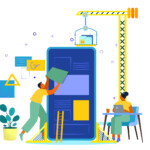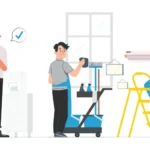Managing a commercial cleaning business means ensuring that every facility meets the highest cleaning standards. But how do you make sure your team is consistently delivering quality work?
The answer is regular janitorial inspections. Without a structured evaluation process, you risk inconsistent results, client complaints, and even lost contracts. A well-designed cleaning inspection checklist helps:
- Ensure consistent cleaning quality across all locations
- Improve team accountability and efficiency
- Enhance customer satisfaction and retention
- Identify safety and maintenance issues early

In this guide, we’ll cover five proven best practices for conducting effective janitorial inspections. Learn how allGeo’s Field Inspection Mobile App can help you automate and streamline your cleaning inspections.
Why Regular Janitorial Inspections Are Essential
A consistent inspection process helps:
- Standardize cleaning quality across multiple facilities
- Boost team accountability and performance
- Elevate customer satisfaction and retention
- Catch maintenance and safety issues early
Below are five proven best practices for effective janitorial inspections—paired with modern solutions that bring them to life in the field.
5 Best Practices for Effective Janitorial Inspections
1. Set Clear Cleaning Standards
Clear expectations are critical. If your team isn’t sure what “clean” means for each facility, performance will vary.
Best Practices:
- Use a detailed checklist to define cleaning tasks
- Provide thorough training on cleaning procedures
- Digitize checklists to ensure easy access and standardization
Solution:
Digital inspection forms make it easy to build customized checklists for each facility. Using smart form logic, teams can follow specific workflows based on the task or location. These forms can be branded, standardized, and updated instantly—helping enforce consistent execution across all locations.
2. Use a Standardized Inspection Process
Inconsistency in inspections often leads to variation in cleaning outcomes. A standardized approach ensures that every inspector evaluates sites the same way.
Best Practices:
- Use a universal inspection form across all job sites
- Maintain consistency in how each checklist is scored
- Store inspection records for accountability and training
Solution:
Mobile inspection tools help supervisors document results with time-stamped photos, ratings, and notes. All records are stored securely and can be accessed anytime for performance reviews, trend analysis, or compliance checks.
3. Go Digital to Save Time & Reduce Errors
Paper-based inspections are inefficient, error-prone, and hard to analyze. Digitizing the process improves productivity and gives managers access to real-time insights.
Best Practices:
- Replace paper forms with mobile checklists
- Capture real-time data for better decision-making
- Automate reports to monitor trends
Solution:
Digital inspection apps work even in offline mode, log GPS and time data automatically, and allow for real-time reporting. Supervisors can generate performance summaries across locations and quickly identify recurring issues or operational gaps.
4. Improve Communication & Team Feedback
Inspections should be a feedback loop—not a fault-finding mission. A good system encourages growth and ongoing improvement.
Best Practices:
- Share inspection results constructively
- Let field teams report issues proactively
- Use inspection data to guide training initiatives
Solution:
Field service platforms can trigger real-time alerts when inspections are completed or issues arise. Notifications help managers stay informed and allow teams to act on feedback or resolve field challenges quickly.
5. Keep Inspections Simple & Actionable
Overly complex inspections can lead to missed steps and poor follow-up. Simplicity encourages consistency and thoroughness.
Best Practices:
- Use a straightforward rating scale (e.g., Below / At / Above Standard)
- Reserve in-depth audits for monthly or quarterly reviews
- Track and follow up on action items
Solution:
User-friendly mobile apps make inspection tasks easy to complete. Field staff can access schedules, forms, and reports in one place, while dashboards help managers monitor performance and assign follow-up actions when needed.
Conclusion: The Future of Janitorial Inspections is Digital
Janitorial inspections don’t have to be time-consuming or inconsistent. By following these best practices and using allGeo’s inspection software, you can:
✔ Save time with digital checklists & automated reports.
✔ Improve cleaning quality with real-time tracking.
✔ Enhance accountability with GPS & timestamped audits.
💡 Stay ahead of the competition—try allGeo today and experience a smarter way to manage janitorial inspections.




